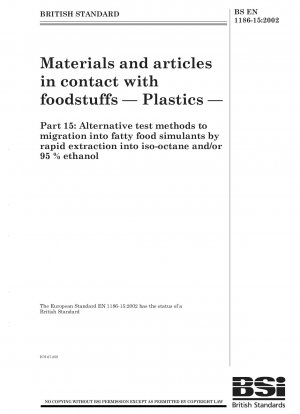BS EN 1186-15:2002
Materials and articles in contact with foodstuffs - Plastics - Alternative test methods to migration into fatty food simulants by rapid extraction into iso-octane and/or 95 % ethanol
- Standard No.
- BS EN 1186-15:2002
- Release Date
- 2002
- Published By
- British Standards Institution (BSI)
- Latest
- BS EN 1186-15:2002
- Replace
- 01/711255 DC-2001
- Scope
- This European Standard specifies two alternative test methods, in the sense of an extraction test with a 'more severe' test character, for the assessment of the overall migration into fatty food simulants. Method A is based on the determination of the extraction of migrateable substances from plastics which are intended to come into contact with foodstuffs, by total immersion in non-polar, iso-octane, and/or polar, ethanol, solvents depending on the polarity of the packaging material. According to results obtained by this method (see [1], [2], [3], [4], [5]) and taking physio-chemical considerations into account, the obtained extraction efficiency has, generally, been found to be equivalent to or higher than overall migration results obtained under the test conditions, 10 days at 40 °C, 2 h at 70 °C, 1 h at 100 °C, 30 min at 121 °C and 30 min at 130 °C. To ensure as complete as possible extraction of the potential migrants, a strong interaction, e.g. swelling, of the sample by the extraction solvent is necessary. For this purpose, iso-octane is used as an extraction solvent for plastics materials and articles containing non polar food contact layers, such as polyolefins. For test samples made from polar food contact plastics such as polyamide and polyethylene terephthalate, 95 % (v/v) aqueous ethanol is used. For polystyrenes, plasticized polyvinyl chloride and other polymers where the identification or polarity of the polymer is not clear, two parallel extraction tests should be conducted using both of the proposed extraction solvents and taking the higher value obtained as the relevant result. NOTE 1 In case of multilayer structures such as plastics laminates and co-extruded plastics, the nature of the food contact layer determines the selection of the extraction solvent(s). This test method should only be applied to flexible packagings which are less than 300 µm in thickness. When the result does not exceed the allowed overall migration limit then the material can be considered to be in compliance with EC regulations. If the test result exceeds the allowed overall migration limit the following options may be applied chronologically with respect to further migration testing: 1) single-sided extraction test using a cell, if technically feasible (see clause 4 Method B of this standard); 2) conventional migration test using olive oil or other fatty food simulants; NOTE 2 The overall migration limit is specified in Commission Directive 90/128/EEC [7] and the conditions of test in Council Directive 82/711/EEC [8] and its subsequent amendments, [9], [10]. Method B is applicable in those cases where the total immersion test, EN 1186-15 Method A, yields total extraction values that exceed the overall migration or may be technically unsuitable, i.e. in the case of multilayer structures, such as plastics laminates and co-extruded films. This test method should primarily only be applied to flexible packagings with a physical barrier layer (for instance of aluminium or other material to prevent penetrative loss of extraction solvent) and which have a thinner food contact layer than 300 µm. If the result does not exceed the allowed overall migration limit then the material can be considered to be in compliance with EC regulations. If the test result exceeds the allowed overall migration limit then the following option may be applied with respect to further migration testing: - conventional migration test using olive oil or other fatty food simulants. NOTE 3 Methods A and B are not applicable to test materials intended for applications over 130 °C. NOTE 4 Test materials intended for applications over 70 °C should be checked for their physical suitability at the intended time and temperature of use.
BS EN 1186-15:2002 history
- 2002 BS EN 1186-15:2002 Materials and articles in contact with foodstuffs - Plastics - Alternative test methods to migration into fatty food simulants by rapid extraction into iso-octane and/or 95 % ethanol
